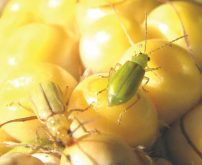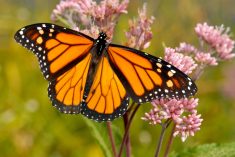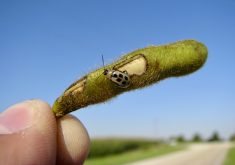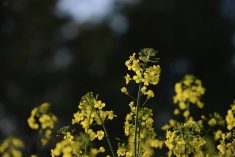Ontario has the dubious honour of being the only province that battles both swede midge and canola flower midge. Worse yet, the two species may work together.
“It’s possible there is a competitive interaction, and one midge will displace the other in terms of successful development,” Rebecca Hallett told attendees of the Ontario Canola Growers meeting last month.
“It’s possible that one helps the other out, and maybe canola flower midge gets in there because swede midge is there. That’s just speculation.”
Read Also

Claas brings 1000 Series SP forage harvesters to Canada
In mid-August, Claas unveiled its new line of Jaguar forage harvesters at an event in Visalia, California, deep in the heart of that state’s dairy region.
Why it matters: Canola flower midge impedes flower bud maturity so it fails to produce seed.
Part of the University of Guelph professor’s ongoing midge research involves determining whether Ontario flower midge migrated from the Prairies, or whether it is a native species that adapted to using canola as a host.
“There are these initial differences that we think we’re seeing in terms of the generations and development,” she said.
“Those will be useful in the future in terms of being able to say when or if management intervention is needed for one species or the other.”

Hallett said Ontario canola flower midge (CFM) uses canola differently than its prairie counterpart, which affects the flower buds but isn’t an issue when it comes to vegetative damage.
“We’re not seeing that, or we’re seeing that very little, so we’re still trying to figure out what CFM is doing here compared to what we know that swede midge does,” Hallett said.
Over the last three years, CFM and swede midge pheromone traps across Ontario from Chatham-Kent and Essex to Nipissing and Timiskaming revealed the midges’ shared fields, confirming CFM is likely widespread throughout the province.
In 2023, Hallett tracked the seasonal abundance of both midge species in three Dufferin County canola fields and the University of Guelph’s Arboretum to assess populations in naturalized areas without brassica crops nearby.
All four sites yielded both species, with swede midge outnumbering CFM in two of the three Dufferin canola sites and CFM outnumbering swede at the Arboretum, although those numbers were small.
Hallett said the Arboretum data supports the working assumption that CFM is a native species recently adapted to canola because of its abundance, particularly in the Prairie provinces.
Her latest project, which began in 2023, seeks to differentiate the two midges’ symptoms, develop a larvae identification analytical genetic procedure, and assess differences in developmental timing, plant placement and impact. Pest management implications are also part of her study.
CFM isn’t causing a substantial economic impact in the West, and while it’s early days for research, Hallett said Ontario’s midge uses canola differently.
“If it’s only recently adapted to use canola as a host plant, then it could become an increasing problem for canola in the future.”
She said Synopeas myles, a parasitic wasp that lays eggs in swede midge larvae, has helped reduce Ontario’s population but does not attack CFM.
“We haven’t seen any other parasitoids in any of the emergence work we’ve been doing for the last 10 years or so,” she said. “And we’re not sure also whether or not there’s any natural enemy that will help to keep canola flower midge in check.”
There hasn’t been enough time for swede midge, an invasive European species, to adapt to the presence of other midge species, said Hallett. If they had evolved together, they would likely engage in niche partitioning while sharing the same host, so one would feed on the roots and another on the leaves, for example.
In this case, they use the whole plant.
Hallett hypothesized that insect success may be determined by which female midge arrives first and lays eggs, allowing larvae to develop and feed on tissue.
“Maybe one facilitates the other, and competition between the two is also possible.”
She’s looking at multiple growing points of a plant in a tub and assessing which midge species emerges.
Her study of a weekly sampling of 162 plants from two Dufferin County areas revealed the midges didn’t partition tissues and emerged during vegetative and reproductive growth points. However, both were more abundant in reproductive tissue.
Hallett’s research team is developing methods to reliably and genetically distinguish the two midge larvae while they grow on the plant. While somewhat unique, CFM morphology is difficult to assess using current processes.
She said differing insecticide susceptibility between the two midges is possible, but that is a subject for a future study.
That will happen “once we figure out how to rear this insect in the lab, which nobody has been able to do yet,” she said. “The unknown is … whether or not there is a natural enemy that affects canola flower midge and how widespread that is in Ontario.”
In this province, CFM’s single generation and emergence appear later in the canola season than swede midge’s multiple generation and emergence, which could limit the damage.
Early canola planting accelerates development of the plant beyond the stage when midges successfully attack, which could limit economic impact, Hallett suggested.
“But we don’t know exactly what it does to canola. Hopefully, we’ll have more definitive answers over the next couple of years.”













